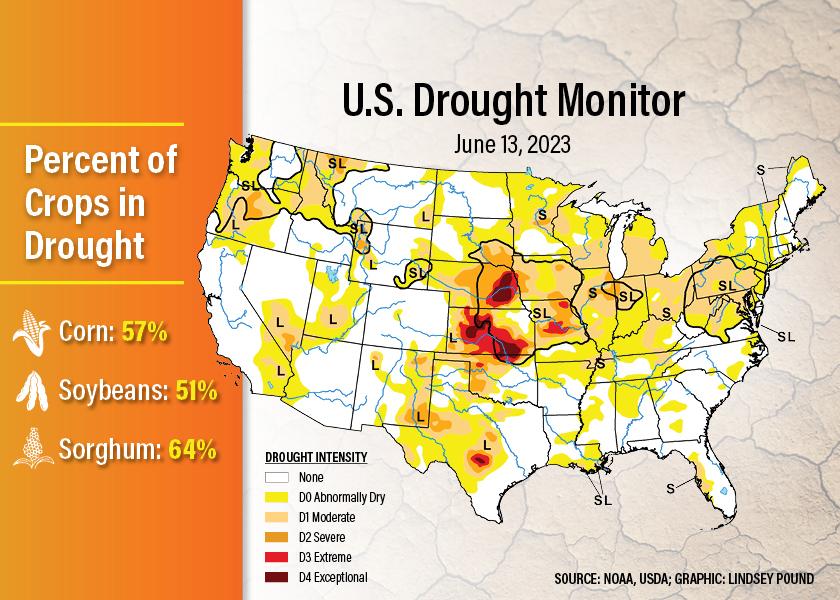Drought Concerns Grow as 57% of Corn, 51% of Soybeans in the U.S. Now Considered to Be in Drought

Drought continues to deepen its grip across the Corn Belt, with Iowa and Illinois seeing some big jumps in the moderate and severe drought categories. As dry conditions expand, it’s also consuming more of the U.S. corn and soybean crops and taking a toll on crop conditions.
The latest national snapshot of drought can be a bit deceiving at first glance. That’s because the U.S. Drought Monitor shows not much change from week to week on a national level, but when you take a deeper dive into the numbers, you see drought conditions worsening in areas of the Midwest, while improving in Texas, Oklahoma and Kansas.
With drought expanding across the heart of the Corn Belt, it means crops are seeing the impacts of the dry conditions. The National Drought Mitigation Center shows drought now covers:
• 57% of the U.S. corn crop
• 51% of soybeans
• 64% of sorghum
• 50% of winter wheat
Those numbers are up from last week, when 45% of corn and 39% of soybeans were covered in drought.
It's not just the corn crop being hit by expanding drought conditions, but also soybeans. USDA and the National Drought Mitigation Center indicates 39% of the U.S. soybean crop is also in drought, which is an 11-point jump in a week's time.
When looking at how much severe drought, of D2, expanded in those areas, the U.S. Drought monitor shows a 13.5 point jump in Illinois, with nearly 15% of the state in severe drought. In Iowa, severe drought grew from nearly 8% last week, to just over 14% this week.

USDA meteorologist Brad Rippey says the key takeaways from the drought monitor updates this week include:
- Large sections of the Midwest have seen 1- to 3-category deterioration over the past month, with a few areas of severe drought (D2) appearing east of the Mississippi River.
- In the western Corn Belt, of course, there are both long- and short-term drought issues, along with some pockets of extreme to exceptional drought (D3 to D4).
Rippey says he's also keeping a close eye on what's coming in the days ahead.
"Currently, blocking high pressure remains in place at higher latitudes of North America," says Rippey. "This blocking feature will only strengthen in coming days, reinforcing the unfavorably dry weather pattern across much of the Midwest."

The Drought Monitor shows nearly 65% of Illinois is now considered to be in the D1 moderate drought category, which is a nearly 15 point jump in just a week. In Iowa, moderate drought expanded nearly 25 points, with 67.5% of the state covered in moderate drought.
Declining Crop Conditions
The story continues to be declining crop conditions in the U.S. USDA-NASS says as of Sunday, 61% of the U.S. corn crop was considered to be good to excellent in crop condition ratings, a 3 point drop in a week.
In Illinois, less than half of the corn crop rated good to excellent, a 2-percentage point drop in a week, but a 21-point decline in two weeks.

Missouri and Illinois are also seeing the worst condition ratings in soybeans, with 45% of Missouri rated good to excellent and 47% of Illinois in the same rating category. Last week, 48% of Missouri's soybeans and 51% of the Illinois soybean crop was rated good to excellent.
A look at current topsoil moisture conditions also shows how drought conditions are expanding. USDA-NASS says nationally 46% of the top soil is reported as short to very short of moisture, up 2 points from last week. The Midwest and Eastern Corn Belt seeing some of the driest topsoil conditions.
A Cool Drought?
Rippey describes the current drought situation as a "cool" drought.
"Today’s crop varieties tend to perform better amid dry spells rather than hot weather," says Rippey. "Subsoil moisture is still plentiful in parts of the eastern Corn Belt, if roots can tap that moisture. On the flip side, subsoil moisture is depleted in parts of the western Corn Belt, so timely rain will be essential to maintaining crop vitality."
He says another thing to consider is the smoke from Canada. He says a northerly flow on the eastern side of the blocking high may continue to deliver smoke and haze to various parts of the U.S., until Canadian wildfires are extinguished.
What to Watch
Rippey says looking ahead, the Seasonal Drought Monitor indicates an expectation for the drought development or persistence across the Eastern Corn Belt.
NOAA's latest drought outlook shows the expectation for drought to continue across eastern Missouri, eastern Iowa, Illinois, Indiana, Wisconsin, Michigan, Ohio and Pennsylvania. NOAA also sees drought conditions developing across more of Illinois, northern Wisconsin and northern Michigan.
Improvements look to be in store for the Western Corn Belt and Plains, with either improving or going away in eastern Missouri, eastern Iowa, Nebraska, Kansas and eastern Oklahoma.

More near-term, Rippey says heat will make a comeback next week, and in a major way. The National Weather Service is forecasting near record-breaking temperatures across eastern Texas and Louisiana.
"A strong sub-tropical ridge of high pressure has recently exerted influence as far north as Texas, where triple-digit heat has developed," says Rippey. "If the sub-tropical ridge links with the Canadian ridge, a 'wall of high pressure' could form across the central one-third of the U.S.

How much has drought grown across the country? Watch the video below to see how conditions have changed over the past month.







